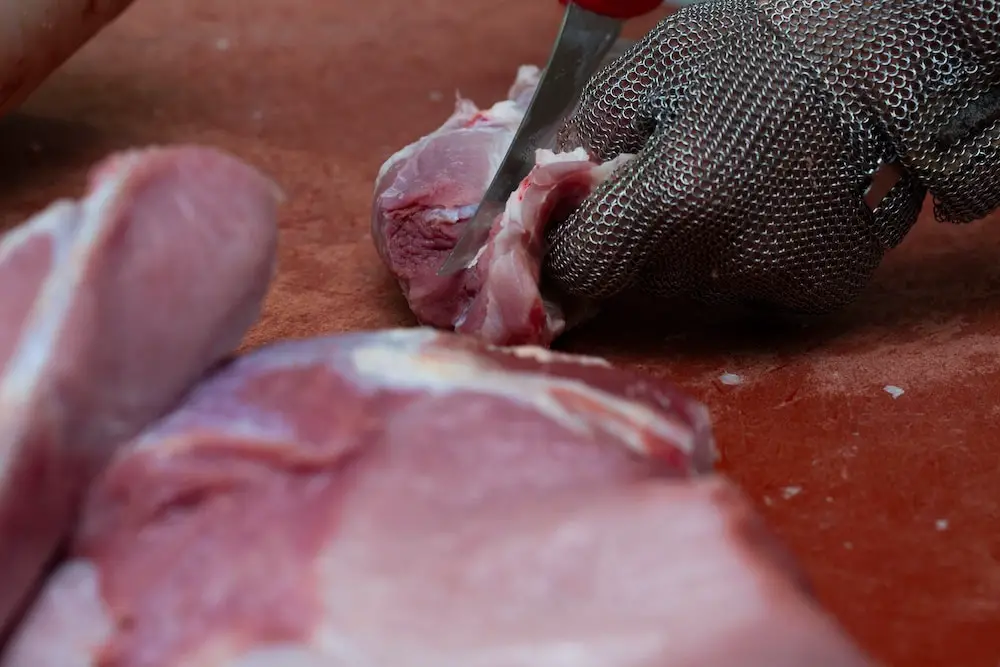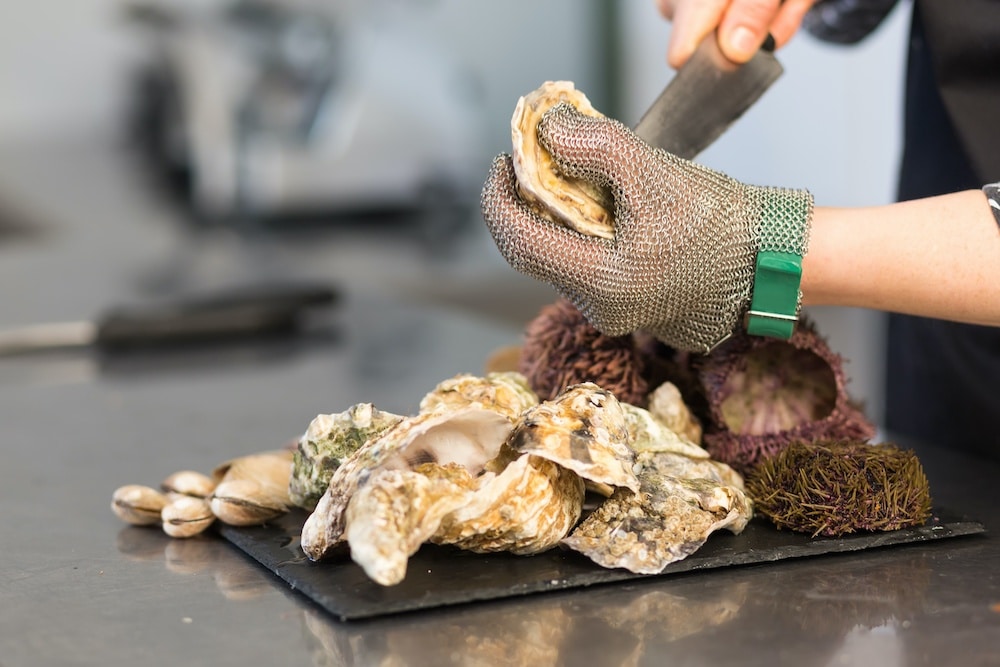Holding sharp objects improperly can result in serious hazards.
The most common among them are lacerations, cuts, and amputations.
Cut-resistant gloves are specifically designed to protect your hands from sharp-edged objects, including ceramics, glass, metals, and other materials.
There are different cut resistant gloves levels, so you can choose according to the object you are using.
Cut Resistant Gloves Levels
The gloves levels play a significant role in recognizing the toughness of the fabric.
This shows how long the glove can withstand direct contact with blades, heat, or chemicals.
You can measure the cut resistance level by taking its small piece and then cutting it in continuous cycles.
The number of cycles required to penetrate the fabric determines its level of cut resistance.
Cut Resistance Level 1
The level 1 gloves provide low-level protection against sharp objects, so you can’t use them with blades or knives.
However, these gloves provide greater efficiency than other levels.
You can use these gloves if you are working with dull objects, such as packages.
Cut Resistance Level 2
The cut resistance level 2 gloves provide more protection than level one but still not suitable for sharp edges.
These gloves are similar to level one in terms of efficiency and movement.
You can use them in areas where contact with sharp objects is common but not a continuous hazard.
Specifically, you can use a pair of level 2 gloves in general handling, warehouses, packing, and shipping.
Cut Resistance Level 3
These work gloves are great for extensive uses.
They can be used in areas where contact with sharp objects is not unusual. These gloves are high resistance, so you can use them with sharp edges.
You can use these gloves daily in warehouses, plumbing, electrical work, and light construction work.
Cut Resistance Level 4
The cut resistant gloves in level 4 are great for use while working with blades, sharp steel edges, or glass.
Although these gloves don’t provide the best protection level, they still offer perfect flexibility.
These gloves are the best option while working in construction, glass or steel handling, automotive, and any other work.
Cut Resistance Level 5
Level 5 resistance gloves provide the highest protection level, which makes them ideal for hazardous environments.
If you are working with blades and sharp objects daily, you should choose these.
These gloves are also resistant to punctures, tears, and abrasion.
You can use these gloves while working with needles, steel or glass handling, and waste material management.
Cut Resistant Glove Ratings
A glove is cut resistant if it meets at least one of the two rating standards: ANSI Standard and EN388 Standard.
The ANSI Standard is only used in America, while the EN388 Standard is a European Standard used worldwide.
That said, both of these standards are different from each other.
You can use them to decide a glove’s resistance.
The cut resistant glove ratings determine how much a glove is resistant to cut.
Categories
Here are four important categories that determine the cut resistant glove ratings:
Abrasion
Abrasion is the number of cycles that a glove material can handle on a rough surface.
The protection rating on the scale is from one to four; the higher the number, the better the glove.
Cut Resistance
Based on the number of cycles, the glove can handle until it breaks down.
The protection is rated on a scale from one to five.
Tear
The tear is based on how much force a glove material can handle until it is torn or ripped.
It has a protection rating of one to four.
The glove rated four is the most tear-resistant.
Puncture
It’s similar to the glove cut resistance levels based on how much force a glove can handle before getting ripped at a single standard point.

ANSI Cut Levels
In 2016, ANSI and ISEA released an updated scale consisting of nine levels of cut protection.
These levels show how many grams of cutting load a glove can handle.
You can see the ANSI Cut Levels on the glove in the shape of a shield.
A1
It refers to level 1 of the protective gloves that can withstand cutting load from 200g to 499g.
You can use it for light cut hazards such as packaging or warehouse.
A2
This level can handle 500 g to 900 g of cutting load.
You can use A2 cut-resistant gloves for light or medium cut hazards like assembling sharp edges or packaging.
A3
You can use the A3 level glove for warehouse, packaging, or forestry.
It can withstand 1000g to 1499g of cutting load.
A4
A4 gloves can withstand the cutting load of 1500g to 2199g.
You can utilize it for medium cut hazards.
A5
ANSI A5 gloves can handle medium or heavy cut hazards such as glass or steel handling.
These can withstand 2200g to 2999g of cutting load.
A6
For high cut hazards, the level A6 of ANSI gloves are perfect.
That’s because they can withstand a cutting load of 3000g to 3999g.
A7
The level A7 gloves are also designed for high cut hazards such as metal recycling or glass manufacturing.
These can withstand the cutting load ranging from 4000g to 4999g.
A8
It is similar to the level A7 but with higher resistance.
It can withstand a cutting load of 5000g to 5999g.
A9
This level provides the highest protection to all the other glove cut resistance levels.
It can withstand 6000g or more of cutting load.
Are Cut Resistant Gloves Cut Proof?
Cut resistance is not always cut proof. It’s specifically designed to reduce the possibility of getting a cut, but you can still get it while working.
Still, wearing cut-resistant gloves can exceptionally reduce the severity of the cut.
Rather than getting your fingers injured, you will hardly get a surface wound.
That is the reason you need to wear cut resistant gloves while handling sharp objects.
You must know about cut resistant gloves ratings before choosing the glove.
That’s because not every type of glove is suitable for handling dangerous objects.
Do Cut Resistant Gloves Work?
According to an estimate, 70% of the workers get finger injuries when they do not wear gloves.
Cut-resistant gloves come in different styles and are made from various materials.
Their safety levels are tested and rated based on both the standards, which are EN388 and ANSI cut levels.
You might be thinking that the high-resistance gloves are the best to buy, but that’s not always the case.
The cut resistant gloves work if you purchase them according to the type of hazard you are facing.
When Should You Wear Cut Resistant Gloves?
Many times laceration and cut accidents happen when you work without wearing cut-resistant gloves.
Therefore, you should always wear them whenever you come in contact with sharp objects.
These gloves are great for handling glass sheets or tubing with sharp edges, sheet metal, broken glass, knives, razor blades, and many other objects having rough edges.
The glove size and cut resistance are the most important aspects when choosing gloves.
Also, don’t forget the cut resistant gloves levels since they determine the cutting severity a glove can withstand.
Conclusion
Even though level 5 cut-resistant gloves provide the highest resistance, they’re not always the best choice for the tasks at hand.
There are many questions that you need to answer while choosing the cut resistant gloves level.
So, make a choice wisely while considering all your requirements.


